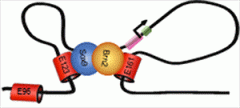Topics
Novel regulatory DNA loops found in gliomas: a promising target for future therapies

Researchers in the laboratory of Dr. Benjamin Deneen, investigator at the Jan and Dan Duncan Neurological Research Institute at Texas Children’s Hospital and associate professor at Baylor College of Medicine, have identified mechanisms in which NFIA, a glial gene, is regulated during normal brain development and in brain tumors. The study published in Nature Neuroscience journal opens new avenues to develop therapies for glioma.
The Deneen lab had previously implicated NFIA in the formation of gliomas which are among the deadliest forms of cancer.
Validating the biological role of enhancers is usually challenging and most researchers use bioinformatics methods to predict putative enhancer regions.
In this study, the researchers used a powerful in vivo system to screen known neuronal enhancers to find which of those could developmentally regulate NF1A expression. Using developing embryonic chick spinal cords, they were able to biologically validate the function of three distinct enhancers for the NFIA gene.
In this study, researchers explored how three layers of regulatory controls, the long-range DNA elements known as enhancers, regulatory proteins known as transcription factors and novel three-dimensional DNA loops, act together to differentially express NFIA gene in glial and neuronal lineages.
During different stages of development, genes are turned on or off in specific tissues and cellular lineages. Various regulatory mechanisms act in coordination to regulate this complex web of gene expression. In the spinal cord, the NFIA gene is specifically expressed in glial cells and its expression is switched off in neurons. Glia comprises 70 percent of the cells in the nervous system and supports the function of neurons.
While scientists have a basic understanding of how these regulatory factors function individually, this study provides the first glimpse into how these regulatory processes cooperate and act together with one another to control gene expression.
Further experiments in mice models showed these three long-range enhancers cooperatively regulate NFIA expression in glia and neurons by binding to distinct lineage-specific transcription factor proteins. Interestingly, researchers found that the region of the NFIA gene that contains these enhancers assumes two distinct three-dimensional conformations in glia and neurons. Furthermore, they demonstrated that these loops preform and provide a permissive configuration for the correct lineage-specific transcription factors to bind to their enhancers.
This pioneering study has identified novel regulatory mechanisms and intermediates, which would be ideal targets to develop specific therapies for gliomas. The researchers were excited to observe that disrupting these 3-D loops decreased NFIA expression reduced glial proliferation and reduced the size of the tumors.




